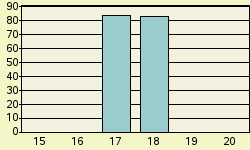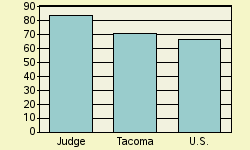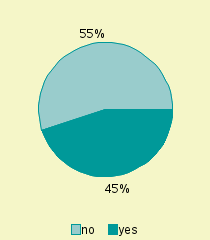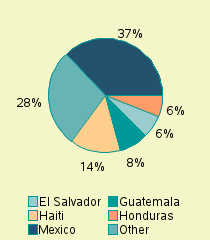Judge Richard Zanfardino
FY 2015 - 2020, Tacoma Immigration Court
Attorney General Loretta E. Lynch appointed Richard Zanfardino to begin hearing cases in September 2016. Judge Zanfardino earned both a Bachelor of Arts degree in 1989 and a Bachelor of Arts degree in 1990 from North Carolina State University, and a Juris Doctor in 1996 from the Columbus School of Law, Catholic University of America. From 2006 to September 2016, he served as a trial attorney for the Office of Immigration Litigation, Department of Justice (DOJ). From 1997 through 2006, he served as an attorney advisor for the Board of Immigration Appeals, Executive Office for Immigration Review, DOJ. From 2003 through 2004, he served as a special assistant U.S. attorney for the U.S. Attorney’s Office, DOJ, in Washington, D.C. Judge Zanfardino is a member of the District of Columbia Bar.
Deciding Asylum Cases
Detailed data on Judge Zanfardino decisions were examined for the period covering fiscal years 2015 through 2020. During this period, Judge Zanfardino is recorded as deciding 216 asylum claims on their merits. Of these, he granted 35, gave no conditional grants, and denied 181. Converted to percentage terms, Zanfardino denied 83.8 percent and granted (including conditional grants) 16.2 percent. Figure 1 provides a comparison of Judge Zanfardino's denial rate fiscal year-by-year over this recent period. (Rates for years with less than 25 decisions are not shown.)
Nationwide Comparisons
Compared to Judge Zanfardino's denial rate of 83.8 percent, nationally during this same period, immigration court judges denied 66.7 percent of asylum claims. In the Tacoma Immigration Court where Judge Zanfardino was based, judges there denied asylum 70.7 percent of the time. See Figure 2.
Judge Zanfardino can also be ranked compared to each of the 526 individual immigration judges serving during this period who rendered at least one hundred decisions in a city's immigration court. If judges were ranked from 1 to 526 - where 1 represented the highest denial percent and 526 represented the lowest - Judge Zanfardino here receives a rank of 193. That is 192 judges denied asylum at higher rates, and 333 denied asylum at the same rate or less often. Ranks are tallied separately for each immigration court. Should a judge serve on more than one court during this period, separate ranks would be assigned in any court that the judge rendered at least 100 asylum decisions in.
Why Do Denial Rates Vary Among Judges?
Denial rates reflect in part the differing composition of cases assigned to different immigration judges. For example, being represented in court and the nationality of the asylum seeker appear to often impact decision outcome. Decisions also appear to reflect in part the personal perspective that the judge brings to the bench.
Representation
If an asylum seeker is not represented by an attorney, almost all (88%) of them are denied asylum. In contrast, a significantly higher proportion of represented asylum seekers are successful. In the case of Judge Zanfardino, 54.6% were not represented by an attorney. See Figure 3. For the nation as a whole, about 19% of asylum seekers are not represented.
Nationality
Asylum seekers are a diverse group. Over one hundred different nationalities had at least one hundred individuals claiming asylum decided during this period. As might be expected, immigration courts located in different parts of the country tend to have proportionately larger shares from some countries than from others. And, given the required legal grounds for a successful asylum claim, asylum seekers from some nations tend to be more successful than others.
For Judge Zanfardino, the largest group of asylum seekers appearing before him came from Mexico. Individuals from this nation made up 37 % of his caseload. Other nationalities in descending order of frequency appearing before Judge Zanfardino were: Haiti (14.4 %), Guatemala (8.3%), El Salvador (6.5%), Honduras (6%). See Figure 4.
In the nation as a whole during this same period, major nationalities of asylum seekers, in descending order of frequency, were El Salvador (18.1%), Guatemala (15.1%), Honduras (14.7%), Mexico (11.8%), China (10.2%), India (3.7%), Cuba (2.5%), Haiti (1.8%), Cameroon (1.5%), Venezuela (1.3%), Nepal (1.3%), Nicaragua (1.1%), Bangladesh (1.0%).




